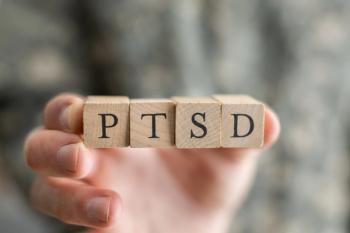
- Psychiatric Times Vol 21 No 4
- Volume 21
- Issue 4
Considering PTSD in the Treatment of Female Victims of Intimate Partner Violence
The distress and functional impairment associated with PTSD may make it difficult for IPV victims to benefit from interventions to increase their safety and reduce their exposure to violence. Empirically supported PTSD treatments include pharmacotherapy and cognitive behavioral therapy. Incorporating these treatments into interventions to improve victims' safety and reduce exposure to violence may improve their effectiveness in protecting women from IPV.
While most anxiety disorders are characterized by fear of a situation or object that people generally do not find threatening, posttraumatic stress disorder develops in response to experiences that would be considered traumatic or terrifying to most people (e.g., a life-threatening situation, serious injury or threat to one's physical integrity). Individuals can respond to these experiences with intense fear, horror or a sense of helplessness. The DSM-IV characterizes PTSD in three clusters of symptoms:
- Persistent re-experiencing: This cluster is characterized by intrusive memories of the event, nightmares, flashbacks, or psychological distress or physiological reactivity when exposed to trauma cues.
- Avoidance and numbing: Many people diagnosed with PTSD make efforts to avoid internal or external cues associated with the trauma, are unable to remember important aspects of the experience, and report loss of interest in activities they once found important. They also often have difficulty feeling connected to others and they expect to have a limited future.
- Hyperarousal: Hypervigilance and irritability are common symptoms included in this cluster. Difficulty sleeping and concentrating, and being easily startled are also common problems.
Johnson and Makinen (2003) noted, "The most significant criticism of the DSM-IV description of PTSD is that this problem is described as rare or unusual." Unfortunately, this does not appear to be true--lifetime prevalence rates of PTSD in women have been reported to be as high as 10% in the general population (Johnson and Makinen, 2003).
These high rates may be accounted for by women's disproportionate likelihood of experiencing trauma, evidenced partly by the prevalence rates of intimate partner violence (IPV). In a survey of women seeking medical care in family practice clinics, Coker and colleagues (2000) found that 55.1% of their sample had experienced some type of partner violence (physical, sexual and/or psychological battery), and 20.2% reported being in a violent relationship at the time of the survey. Koss et al. (2003) reported that 10% to 15% of women are victims of physical violence from intimate partners each year. The pervasiveness of IPV, along with the severity of its sequelae, constitutes a major public health problem (Rhodes and Levinson, 2003).
Mental health problems such as depression, substance abuse and anxiety are common among victims of partner abuse (Campbell, 2002). The most prevalent sequela of IPV, however, is PTSD. The prevalence of PTSD in victims of IPV has been found to be as high as 63.8% (Golding, 1999). This prevalence rate is especially alarming when compared to lifetime estimates of PTSD in the general population, which vary from approximately 1% to 12% (Golding, 1999). While many mental health problems overlap in victims of IPV, other mental health symptoms (i.e., depression, substance use) may be best conceptualized as symptoms of PTSD, rather than as comorbid disorders (Golding, 1999). Giving the diagnosis of PTSD to victims of IPV who meet its criteria may improve treatment efficacy by helping to remove self-blame through emphasis on the external rather than internal origin of the symptoms (Hughes and Jones, 2000). This can serve to reduce the victim's anxiety and sense of powerlessness. However, even though the rates of PTSD and other psychiatric disorders among victims of IPV are extremely high, most treatment strategies to improve safety and reduce exposure to abuse among female victims of IPV do not target psychological symptoms (Jones et al., 2001).
- Interventions for IPV
For the purpose of this article, we will address female victims of male violence. We have chosen to limit our review in this way for a number of reasons. First, 85% of victims of IPV are women (Greenfield et al., 1998), and women suffer more severe physical injuries after domestic violence than men do (Golding, 1999). In addition, mental health sequelae for men who have been battered have not been well-researched (Golding, 1999). Little is known about the mental health consequences of same-sex partner violence (Golding, 1999).
Interventions to improve safety behaviors among victims of IPV are effective in reducing the frequency of abuse that some women experience (McFarlane et al., 2000). Parker and colleagues (1999) tested a three-session intervention to improve abused pregnant women's sense of empowerment by teaching them safety behaviors. They targeted this population because abused pregnant women are at greater risk for suicide attempts, substance abuse and complications during pregnancy (Parker et al., 1999). During the three-session intervention, women met individually with a counselor to develop a safety plan. They were advised to secure copies of important documents and extra keys, establish a code with family and friends, hide extra clothes, and identify behaviors of the abuser that indicated increased danger. The intervention was effective in reducing incidents of abuse compared to a control group at six months and 12 months post-delivery. However, the women's PTSD status was not assessed.
Physician intervention at primary care or family medicine appointments has also been shown to be effective in reducing exposure to abuse in some women (Rhodes and Levinson, 2003). Coker and colleagues (2002) demonstrated that when physicians asked a single screening question regarding whether women were experiencing abuse, the women benefited in several ways. Physicians were more likely to document the abuse, which is helpful if women decide to get a restraining order or take legal action. The women were more likely to take action to improve their safety once they had disclosed the abuse to their physician. Physicians were also able to make referrals to help the women improve their safety or leave the abusive relationship.
The emergency room is another setting in which screenings and referrals can occur. However, whether emergency room screenings are effective in reducing abuse is yet to be determined empirically (Fanslow et al., 1999). Rhodes and Levinson (2003) illustrated that it may be beneficial for primary care and emergency medicine physicians to screen all of their female patients for IPV. However, we were unable to find recommendations that women who screened positive for IPV should also be screened for PTSD.
Another common intervention focused on decreasing IPV is couples therapy. Holtzworth-Munroe and colleagues (2003) noted, "Over half of all couples seeking couples therapy have experienced husband physical aggression in the past year." While treatment involving both partners may be controversial, there is evidence that this type of intervention is as effective in reducing IPV as are gender-specific therapies (Holtzworth-Munroe et al., 2003). In fact, a study conducted by Schlee and colleagues (1998) was the only study we were able to locate that specifically assessed the impact of a PTSD diagnosis on treatment outcomes in female victims of IPV. Participants in this study were couples involved in a group treatment program focused on decreasing spousal abuse. Overall, the women reported a significant decrease in fear of their spouses, depressive symptomatology, and reports of their partners' physical and psychological abuse. The women also reported an increase in marital satisfaction. There were no significant differences on any of these outcome measures between women with and without PTSD. In addition, dropout rates were not different between the two groups. However, the authors did not assess for changes in levels of PTSD pre- and posttreatment.
- PTSD Treatment
Although the interventions reviewed above do not typically assess for or target PTSD, the addition of pharmacological and/or psychotherapeutic treatments that target PTSD symptoms may help to reduce the distress and functional impairment that IPV victims with PTSD experience. Pharmacological treatments that have empirical support from randomized trials for their efficacy in reducing symptoms of PTSD include tricyclic antidepressants, monoamine oxidase inhibitors and selective serotonin reuptake inhibitors. Considering reported overall efficacy and side-effect profiles, SSRIs are emerging as the first-line treatment for PTSD (see Albucher and Liberzon [2002] for a review of pharmacotherapeutic trials for treating PTSD). Although there is empirical support for the use of pharmacological approaches to manage the symptoms of PTSD, pharmacology alone does not appear to fully alleviate the disorder or address certain symptom clusters such as avoidance (Albucher and Liberzon, 2002).
In a recent review of the psychotherapy literature, Solomon and Johnson (2002) reported that combined cognitive and behavioral treatments have the strongest empirical support for efficacy with PTSD symptoms. In addition, these approaches may be the most effective for addressing the avoidance symptom cluster of PTSD. This may be particularly important in the treatment of IPV victims--Schlee and colleagues (1998) found that avoidance symptoms were the best predictors of treatment dropout rates in female victims of partner violence. Cognitive-behavioral treatments for PTSD generally include education regarding the nature of PTSD, exposure and response prevention to memories of the traumatic event, stress inoculation, and challenging the cognitions that may be stuck points for patients (Meichenbaum, 1994). One variant of cognitive-behavioral therapy specifically designed for the treatment of PTSD after sexual assault is cognitive processing therapy, which uses the aforementioned therapeutic techniques organized around the issues of safety, trust, power, control, esteem and intimacy (Schnicke and Resick, 1993).
Unfortunately, while there is empirical support for pharmacological and psychotherapeutic treatment modalities for PTSD, there are no studies specifically addressing the efficacy of PTSD treatments for female victims of partner abuse (Jones et al., 2001). However, Jones and colleagues (2001) argued that preliminary treatment suggestions such as using the PTSD treatment modalities discussed above are appropriate based on the literature about the nature of PTSD in IPV victims and empirically supported treatments for PTSD.
- Conclusions
Considering the extremely high prevalence rate of PTSD in female victims of IPV and the availability of empirically supported pharmacological and psychotherapeutic interventions for PTSD, it is surprising that none of the interventions reviewed above typically assess for or directly target symptoms of the disorder. Jones and colleagues (2001) posited that this mismatch between symptoms and treatment strategies may be iatrogenic for IPV victims. Indeed, there is evidence that female victims of IPV with PTSD are significantly more impaired than female victims of IPV without PTSD (Laffaye et al., 2003). Ignoring these more severe symptoms in intervention efforts also ignores significant impairment in the majority of victims. Posttraumatic stress disorder may, in fact, act as a barrier for women to follow up on physician referrals or to take part in structured interventions to reduce violence. Posttraumatic stress disorder may also act as a mediator of treatment outcome, with women who are more impaired by the disorder being less likely to benefit from intervention. If PTSD were identified in these high-risk individuals, the disorder could be treated directly, thus making it more likely that these women would benefit from the interventions reviewed above.
References:
- References 1. Albucher RC, Liberzon I (2002), Psychopharmacological treatment in PTSD: a critical review. J Psychiatr Res 36(6):355-367.
2. Campbell JC (2002), Health consequences of intimate partner violence. Lancet 359(9324):1331-1336 [see comments].
3. Coker AL, Bethea L, Smith PH et al. (2002), Missed opportunities: intimate partner violence in family practice settings. Prev Med 34(4):445-454.
4. Coker AL, Smith PH, McKeown RE, King MJ (2000), Frequency and correlates of intimater partner violence by type: physical, sexual, and psychological battering. Am J Public Health 90(4):553-559.
5. Fanslow JL, Norton RN, Robinson EM (1999), One year follow-up of an emergency department protocol for abused women. Aust N Z J Public Health 23(4):418-420.
6. Golding JM (1999), Intimate partner violence as a risk factor for mental disorders: a meta-analysis. J Fam Violence 14(2):99-132.
7. Greenfield LA, Rand MR, Craven D et al. (1998), Violence by intimates: analysis of data on crimes by current or former spouses, boyfriends, and girlfriends. Washington, D.C.: U.S. Department of Justice, Office of Justice Programs, Bureau of Justice Statistics.
8. Holtzworth-Munroe A, Marshall AD, Meehan JC, Rehman U (2003), Physical aggression. In: Treating Difficult Couples: Helping Clients with Coexisting Mental and Relationship Disorders, Snyder DK, Whisman MA, eds. New York: Guilford Press, pp201-230.
9. Hughes MJ, Jones L (2000), Women, domestic violence, and posttraumatic stress disorder (PTSD). Available at:www.csus.edu/calst/government_affairs/reports/ffp32.pdf . Accessed March 2, 2004.
10. Johnson SM, Makinen J (2003), Posttraumatic stress. In: Treating Difficult Couples: Helping Clients with Coexisting Mental and Relationship Disorders, Snyder DK, Whisman MA, eds. New York: Guilford Press, pp308-239.
11. Jones L, Hughes M, Unterstaller U (2001), Post-traumatic stress disorder (PTSD) in victims of domestic violence: a review of the research. Trauma Violence Abuse 2(2):99-119.
12. Koss MP, Bailey JA, Yuan NP et al. (2003), Depression and Ptsd in survivors of male violence: research and training initiatives to facilitate recovery. Psychol Women Q 27(2):130-142.
13. Laffaye C, Kennedy C, Stein MB (2003), Post-traumatic stress disorder and health-related quality of life in female victims of intimate partner violence. Violence Vict 18(2):227-238.
14. McFarlane J, Soeken K, Wiist W (2000), An evaluation of interventions to decrease intimate partner violence to pregnant women. Public Health Nurs 17(6):443-451.
15. Meichenbaum D (1994), A Clinical Handbook/Practical Therapist Manual for Assessing and Treating Adults with Post-Traumatic Stress Disorder (PTSD). Waterloo, Ont., Canada: Institute Press, pp388-389.
16. Parker B, McFarlane J, Socken K et al. (1999), Testing an intervention to prevent further abuse to pregnant women. Res Nurs Health 22(1):59-66.
17. Rhodes KV, Levinson W (2003), Interventions for intimate partner violence against women: clinical applications. JAMA 289(5):601-605 [see comment].
18. Schnicke M, Resick PA (1993), Cognitive Processing Therapy for Rape Victims: A Treatment Manual. Newbury Park, Calif.: Sage Publications.
19. Schlee KA, Heyman RE, O'Leary KD (1998), Group treatment for spouse abuse: are women with PTSD appropriate participants? J Fam Violence 13(1):1-20.
20. Solomon SD, Johnson DM (2002), Psychosocial treatment of posttraumatic stress disorder: a practice-friendly review of outcome research. J Clin Psychol 58(8):947-959.
Articles in this issue
over 21 years ago
Guideline to Aid Treatment of Suicidal Behaviorover 21 years ago
Addressing Metabolic Effects in Childrenover 21 years ago
Intervention and Prevention of Morbid Psychosocial Outcomesover 21 years ago
A New Appreciation of ECTover 21 years ago
Preventing Violence in Schoolsover 21 years ago
Less Anxiety But More Violence?over 21 years ago
Posttraumatic Growth: A New Perspective on PsychotraumatologyNewsletter
Receive trusted psychiatric news, expert analysis, and clinical insights — subscribe today to support your practice and your patients.













